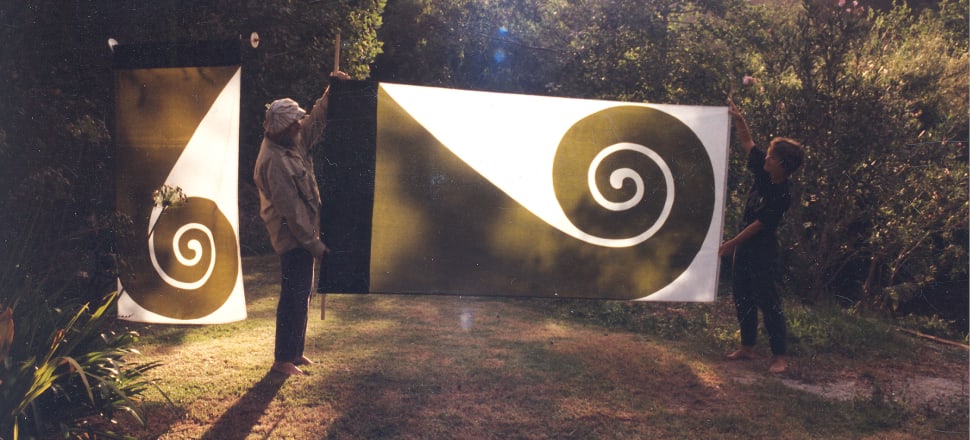
The life and times of a genius
In a photograph taken in 1968, the Austrian/New Zealand painter Friedensreich Hundertwasser is laid out on a stack of incoming mail the size of a bed. Afloat on this sea of expectations, requests and comments as well as high praise, he rests with his hands behind his head as though lying on his back, mid-ocean, oblivious to all of it.
Hundertwasser was phenomenally famous for some years before his first visit to Aotearoa in 1973, when he accompanied a travelling exhibition of his work to the Auckland City Art Gallery. His ‘New Zealand’ life, which spanned 27 years—from that visit until his death in 2000—was spent in relative seclusion, a refugee from celebrity and the demands of his European life. Lengthy stays at Kaurinui, the 200 hectare property he acquired in the Bay of Island district, would be punctuated with periods spent back in Austria or working on projects around the world.
Born in Vienna in 1928, the first two decades of Hundertwasser’s life were as unsettled and traumatic as you would expect for an Austrian of Jewish descent at that time. It was while living in a flat with his mother beside the Danube Canal—as author Andreas J. Hirsch relates in the newly published Hundertwasser in New Zealand: The Art of Creating Paradise —that Hundertwasser first heard mention of "a country in the Southern Hemisphere… an antithesis to the reality of Austria in his childhood…a place of untouched nature, where there was no war".
An idea of New Zealand as an ‘earthly paradise’ existed well before he set foot on the place. Later he would associate the country with the spiral-form which, according to his philosophy, symbolised creation and encompassed both life and death. "I painted the spiral long before I came to New Zealand," he once said in an interview. "So I was a New Zealander long before I came here. When I arrived here I saw the spiral everywhere. In advertising, on Māori tattoos, in everyday life..."
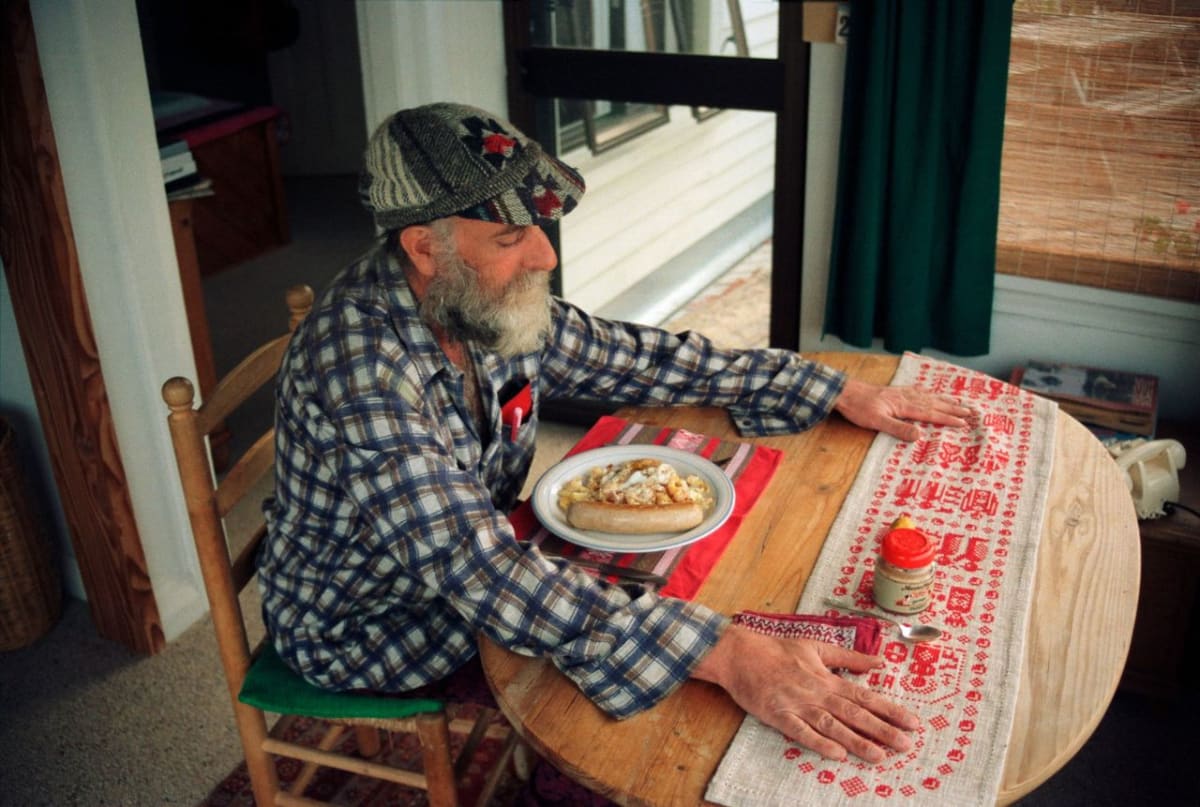
It was on a subsequent visit that he came upon a section of degraded farmland for sale and knew he had found his antipodean base. Justifying the purchase of the Kaurinui property to a local notary, he stated his intention to restore the wetlands adjoining the lagoon and to create a bird sanctuary and innovative agricultural project. Upon taking possession, Hundertwasser set to work doing just that. A map of the Kaurinui Inlet, reproduced as endpapers in the new book, includes the names he bestowed upon his recently acquired lands: Brueghel Grove, Hokusai Valley, Rousseau Meadow and Klimt Grove. There was even a pond in honour of 19th Century Swiss painter Arnold Bocklin. You can imagine his delight strolling out into the antipodean dawn each day, navigating the squelchy path beside Schiele Grove, then proceeding, by way of Brueghel and Hokusai, as far as a valley named after his outsider-art-hero, Friedrich Sonnenstern.
Even the erratic summer showers of Northland were a delight. "On a rainy day the colours begin to glow," he wrote. "That is why a dull day—a rainy day—is for me a fine day." A devotee of bad weather, winter, and rainy days—all of which Northland offered aplenty—he had a passionate interest in the hydrosphere, in the fluidity and patterning of ocean currents, swirling fresh water systems and the cyclic nature of all planetary life.
In most photographs taken of him here, Hundertwasser is solitary—standing or sitting in his adopted landscape. A swanndri soon replaced the stripey jacket seen in early photographs. Not that he ever left Europe completely behind. He employed a team of staffers and collaborators back in Vienna, some of them no doubt dealing with the daily deluge of mail. His fax machine in the Bay of Islands churned away, day and night, keeping him abreast of projects, proposals, exhibitions and business matters.
Periodically he leapt up into the public eye here but mostly he kept his head down. His well-known proposal for a new national flag incorporating a green koru garnered a following and still flies from numerous flagpoles around the country. An architectural plan he devised for the proposed Museum of New Zealand received a muted reception but his designs for the Kawakawa public toilets came to fruition in 1999 and the facility now brings an estimated 150,000 visitors to the Northland town each year.
Hundertwasser in New Zealand has been published to coincide with the opening, earlier this year, of an even more imposing creation in the northernmost province. Whangarei’s Hundertwasser Art Centre and adjoining Wairau Māori Art Gallery are cause for much jubilation. With its onion-dome tower and rooftop forest, this newest addition to the city’s generally nondescript skyline is, from all accounts, more than reason enough to hit the road northwards at the first opportunity.
The building—the genesis of which is well-described in the book—is very much the reflection of the man. Most of the time, Hundertwasser would wear a range of squashy hats and caps, some of them echoing the shape of Whangarei’s freshly cut onion dome (which in turn echoed, in his mind, a drop of water, rain, a teardrop). Hundertwasser was many things: colourful, brilliant, prolific, iconoclastic, environmentally in-the-know, multi-talented, contentious, saintly, gruff. Hundertwasser in New Zealand covers the months and years spent largely in Northland and features a good number of the paintings produced and projects gestated there. His tenure in his earthly paradise ended prematurely not long after his departure for Europe on the Queen Elizabeth II in February 2000, barely two months after the opening of the Kawakawa public toilets. He died of a heart attack while the cruise ship was off the Queensland Coast. His body was returned to his land at Kaurinui where he was buried in a shallow grave, naked, with a koru flag wrapped around him. As he stipulated, a tulip tree was then planted to mark the site, appropriately sited in The Garden of the Happy Dead.
As well as being an ardent conservationist, Hundertwasser was passionate about world peace, designed Save the Whales posters and was a spirited advocate for the greening of urban spaces. He proposed a concept of "tree tenants" for the balconies and rooftops of inner city buildings. Yet he could be a contrary figure. He was also an ardent nationalist and thought the European Economic Union a terrible idea. He remained a life-long admirer of Margaret Thatcher. There were other paradoxes too: He was a communicator and yet a recluse; he was clearly a savvy businessman, but he loved being in New Zealand because he could live here "without money".
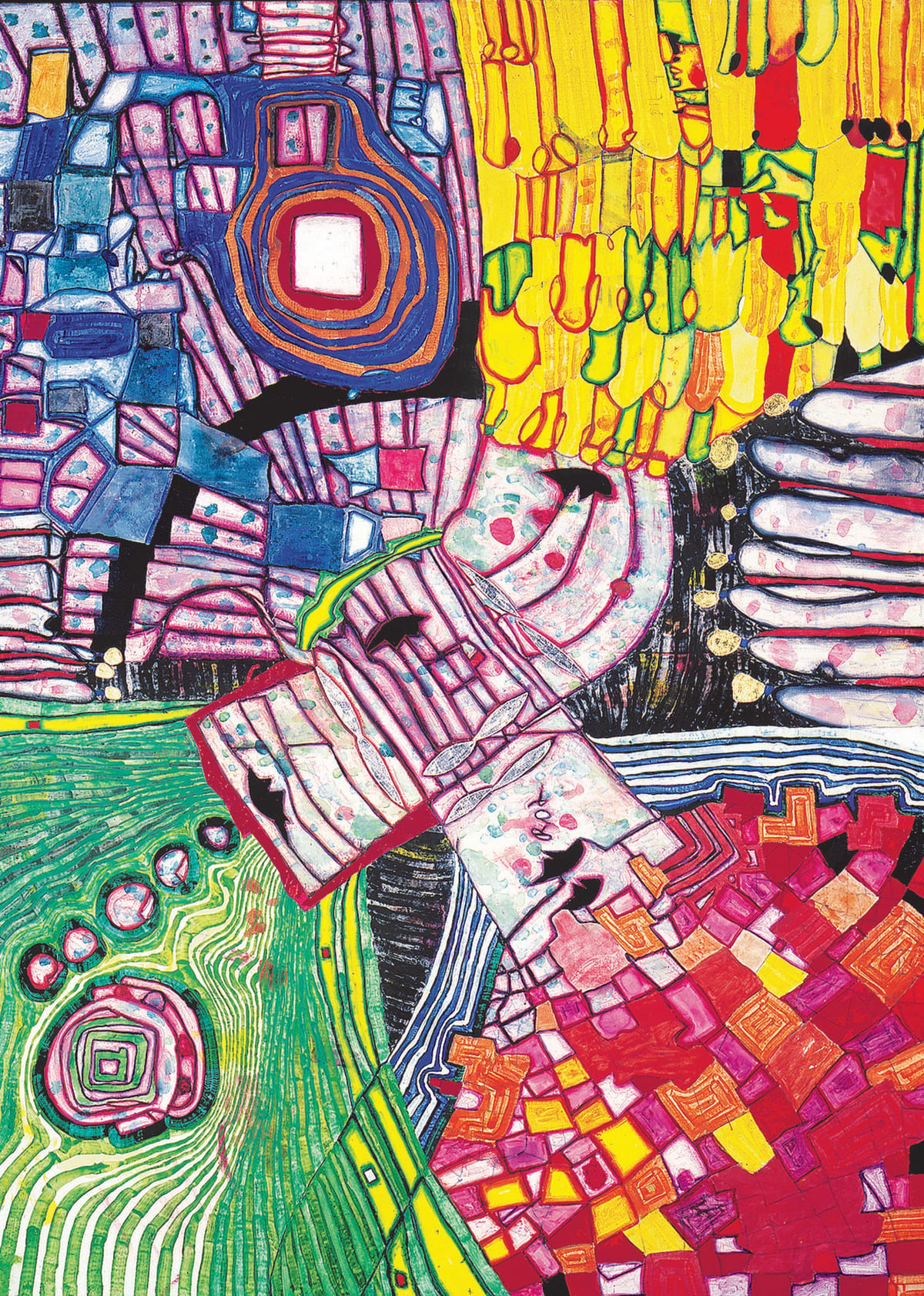
His reputation exists a little outside the Fine Arts mainstream. While his art is sometimes dismissed on account of its incessant high spiritedness, some would say frivolity, it is worth remembering that Paul Klee and Alexander Calder, amongst the officially sanctioned Moderns, were tarred with the same brush—but somehow got away with it. The hyperactivity and busy-ness of his work—with its ‘dancing windows’ and ornamental add-ons—are not much in keeping with Modernism’s sleek, reductive project. Architects criticise his building designs for not really engaging with problems of space and structure. Far closer to Gaudi than Le Corbusier, Hundertwasser believed that symmetry in building was to be avoided: "Today we live in a chaos of straight lines, in a jungle of straight lines." The Whangarei building unapologetically plays out that viewpoint.
On occasion, Hundertwasser was accused of running a commercial rather than an artistic operation. During the 1970s and later, the shelves of bookshops and galleries worldwide were awash with Hundertwasser prints, posters, greeting cards, diaries, books, calendars and other merchandise. A prolific worker and thinker who designed dozens of realised and unrealised architectural projects, his artistic output extended to over 1000 paintings and 100 limited edition screen prints (some of which were printed in signed editions as large as 10,000). As these numbers suggest, his imagery—and associated messaging—went far and wide. His artistic work also realised some considerable capital, much of which he channelled into conservation and related matters, among them the 150,000 trees he planted in Kaurinui Valley.
*
Thinking back over my own teenage years, like many who came of age in the 1970s I ascribe some considerable status to Friedensreich Hundertwasser. His highly patterned, gleaming land/cityscapes offered a link between the psychedelic posters and Roger Dean-style record covers that defined that period, on the one hand, and ‘serious art’ on the other. He led a good number of us, I suspect, in the direction of Paul Klee, Gustav Klimt, and onward into the history of 20th century art. His work also offered a continuation of the kind of European imaginative flight I first experienced in Tove Jansson’s Moomintroll books. What sensible, responsive child would want to leave behind such joyful, translucent strangeness? And what a relief it was, as an avid pencil-case scrawler, to discover such a living, breathing vindication of compulsive doodling.
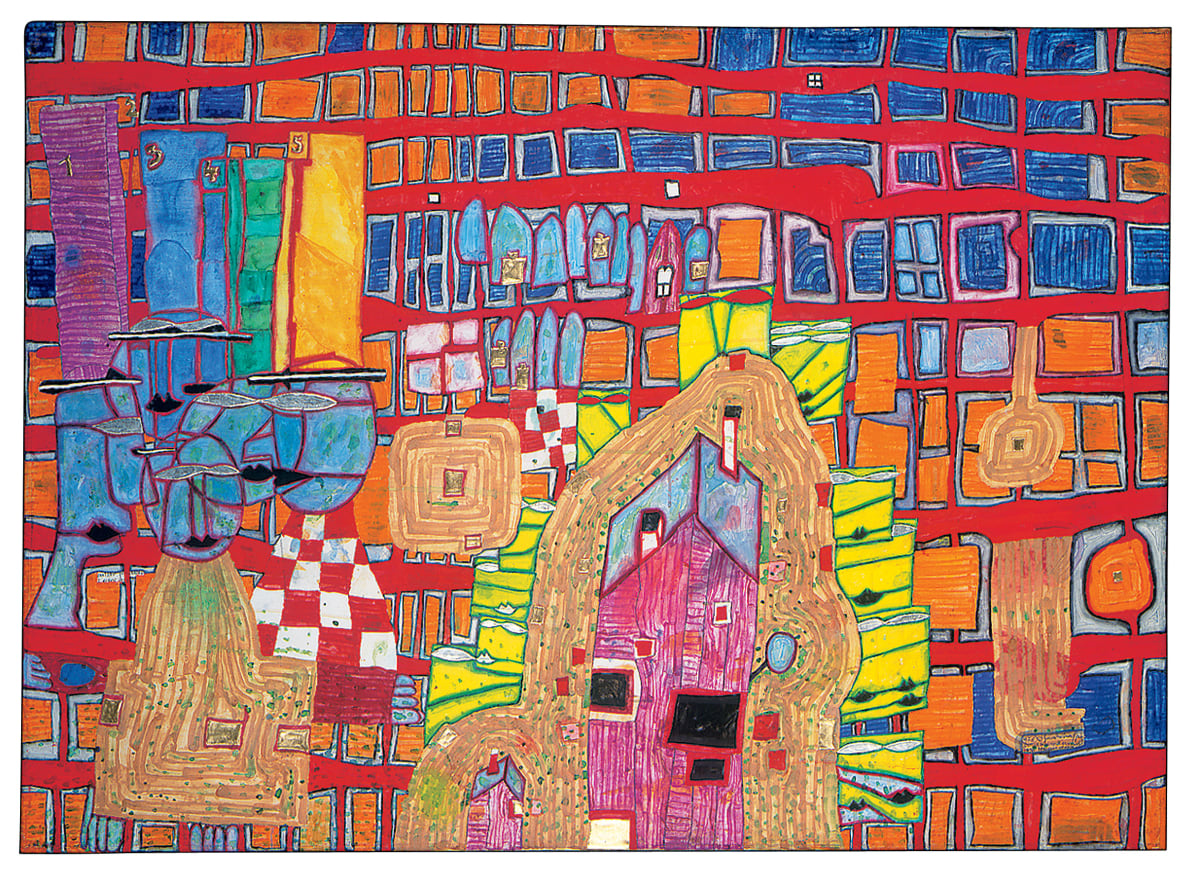
Hundertwasser has been a bridge between other things besides High and Low Art. His work straddles notions of North and South, the sacred and the profane, exotic and indigenous, art and life... With such a quality in mind, it feels apposite that the exterior of the recently completed Hundertwasser/Wairau building resembles a bridge, albeit one that spans an expanse of what once was asphalt rather than the adjacent Hatea River. There’s a Hundertwasser-esque logic to that fact too: The carpark is the thing that we need to be getting over—the river can happily be left to its own devices.
The arching curve of the building also resembles an undulation in a landscape, as do the floors inside. From the first design drawings he made of the museum project in the early 1990s, the structure was also, in his mind, a rolling wave or ocean swell, harking back to his years spent living and travelling on the vessel he christened Regenstag (Rainy Day).
*
A trademark Hundertwasser painting looks like an aerial view, a map or floor plan that has been hyper-colourised, put through a blender, then colonised by science fictional lifeforms. Everything flows. The colours have the brightness of glazed ceramics. If the paintings reproduced in the present book are anything to go by, maybe the colour green became more prevalent and the compositions less cluttered when he was at his southern home. However, generally, his artistic style appears to have been settled well before he reached these shores.
The book leaves unanswered a few questions about his life in Aotearoa. Although he knew artists such as Guy Ngan and Michael Illingworth, his interactions with the local art world were minimal. In the Bay of Islands district, he fell in with a good crowd of ecologically minded locals—among them the Fagan family (including singer/sailor Andrew, of The Mockers fame) and Richard Smart, who was to be instrumental in the art gallery project in recent years (for which he certainly deserves, in good time, his own tulip tree in The Garden of the Happy Dead). Generally, however, the book feels like an outsider’s perspective on Hundertwasser’s existence in Aotearoa. Local readers will be left wondering to what extent he was involved with local iwi and whether he saw his creative/conservationist project on their terms. From what I’ve heard elsewhere, his engagement with Māoridom was extensive and reciprocal. It would be good to know more. With the Wairau Gallery of Contemporary Māori Art (which was his idea initially) running in tandem with the Hundertwasser gallery, an overlapping of the Austrian and indigenous streams is inevitable and hopefully we will be hearing more.
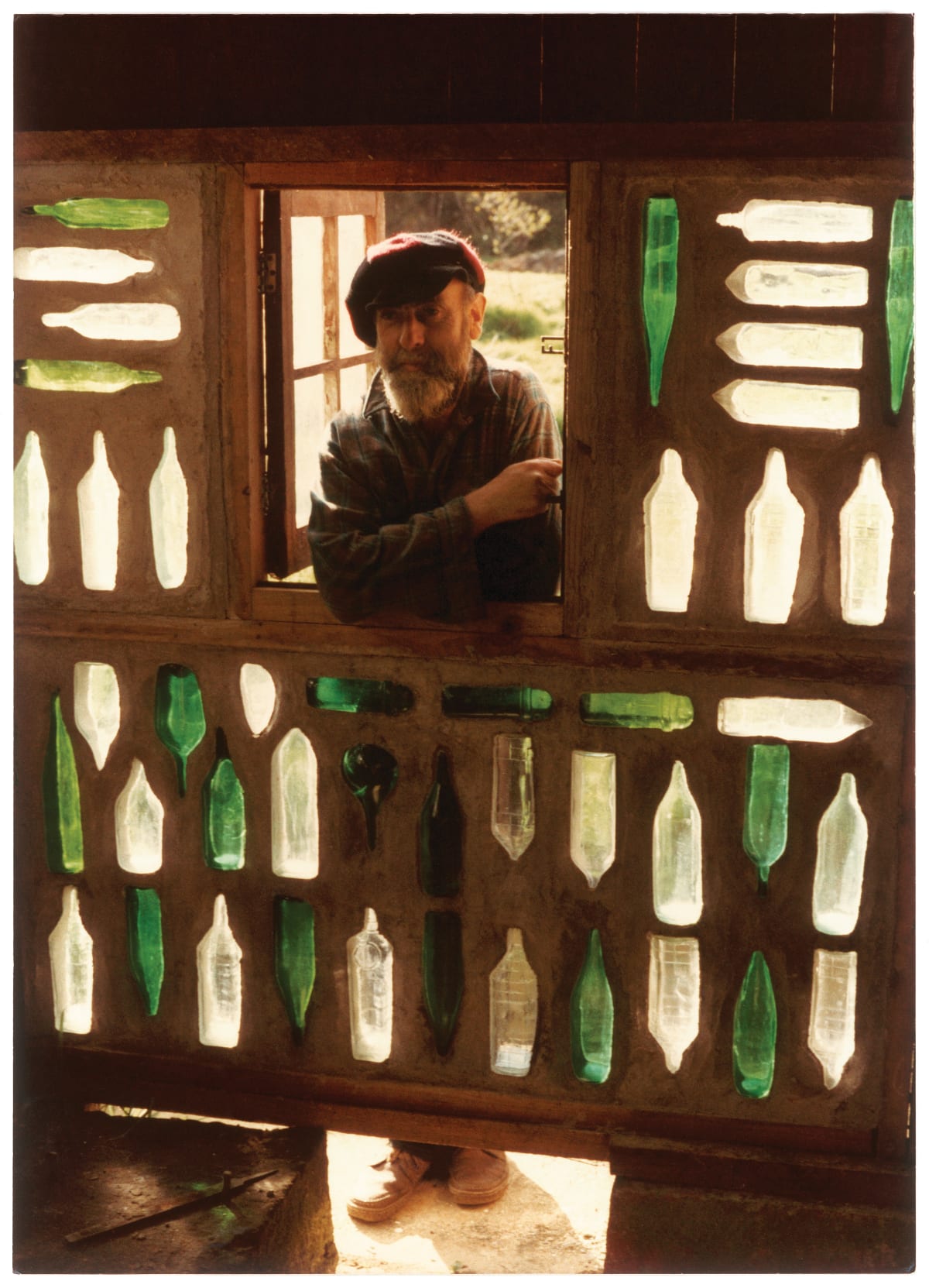
Upon finishing the book, I emailed my film-maker friend Florian Habicht, who grew up as a member of an Austrian émigré family just down the road from Kaurinui. Florian recalled their always-well-hatted neighbour appearing on the family’s doorstep mid-morning, when his mother was making traditional Austrian wiener sausages. (Despite his avowed greenness, Hundertwasser was no vegetarian, and—as also noted by Florian—he patronised the Kawakawa fish and chip shop with gusto and frequency.) A man of great generosity as well as appetite, he would, as an earlier writer Wieland Schmied has noted, serve his guests at Kaurinui "a breakfast salad of hand-picked nettles, dandelion greens, bear’s garlic, hedge garlic with a soy-sauce dressing, accompanied by a wheat galette made of ground chicken feed and wheat-and-rye bread he had baked himself". This is the Hundertwasser I would have liked to see a little more of in the pages of the present book. Chicken feed! But why? While the artist’s career and projects are well outlined here, the figure himself, and the textures and sounds and smells of his everyday life in the paradise garden, are less manifest.
While Hirsch notes the appearance of communes and other rural-based initiatives in New Zealand at the time of Hundertwasser’s arrival, his artistic project becomes even more interesting when you see it in the context of local art-making. His ruminations on paradise would play well alongside those of Pat Hanly; his dreamy narratives alongside Gary Tricker’s etchings. His ribbon-like roadways would be fascinating considered alongside the early 1960s motorway paintings of another adopted Northlander, Robert Ellis. Hopefully the exhibition programme at the museum will explore some of these connections in the future.
During one of Hundertwasser’s first visits here, he travelled south to Coromandel to visit Michael Illingworth. He also visited Barry Brickell’s pottery and conservation project at Driving Creek. In Brickell he would have recognised a kindred spirit. Both men were committed not only to art-making but also to writing manifestos, exploring recycling and alternative toilet technologies, and given to a feisty, unapologetic nudism. (That said, Brickell’s lifelong commitment to celibacy was never a priority for his Viennese counterpart.) As an independent spirit, a philosopher artist and a utopian dreamer, Hundertwasser also has much in common with Len Lye, whose philosophy of ‘Individual Happiness Now’ overlaps considerably with the Austrian’s almost religious belief in joy and creative play. With the Len Lye Centre already up and running in New Plymouth and Brickell’s Driving Creek Railway and Pottery thriving just outside Coromandel township, we might now think of the Hundertwasser/Wairau museum as a further, equally notable manifestation of radical, visionary provincialism. Like Hirsch’s book, it also stands as a testament to an exceptional life’s work, an immigrant’s tale and a paradoxical yet compelling personality. As Florian Habicht says, by way of a summary: "He was a man of few words. Very modest and humble in New Zealand. And he lived without money here. It was as if money didn't exist in New Zealand! He always wore odd socks. His New Zealand home was full of beautiful spiderwebs."
Hundertwasser in New Zealand: The Art of Creating Paradise by Andreas J. Hirsch with translation by Uta Hoffmann (Oratia Books, $70) is available in bookstores nationwide.







